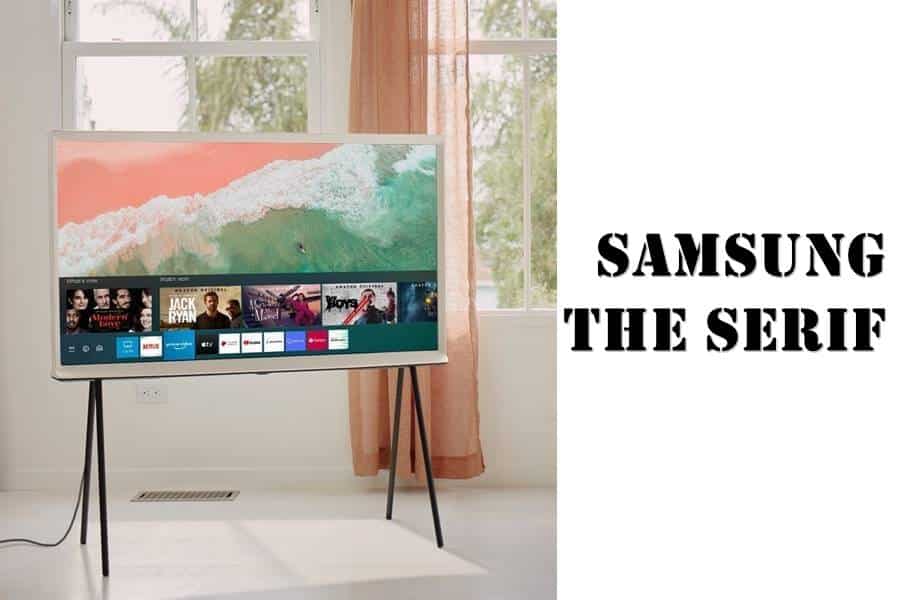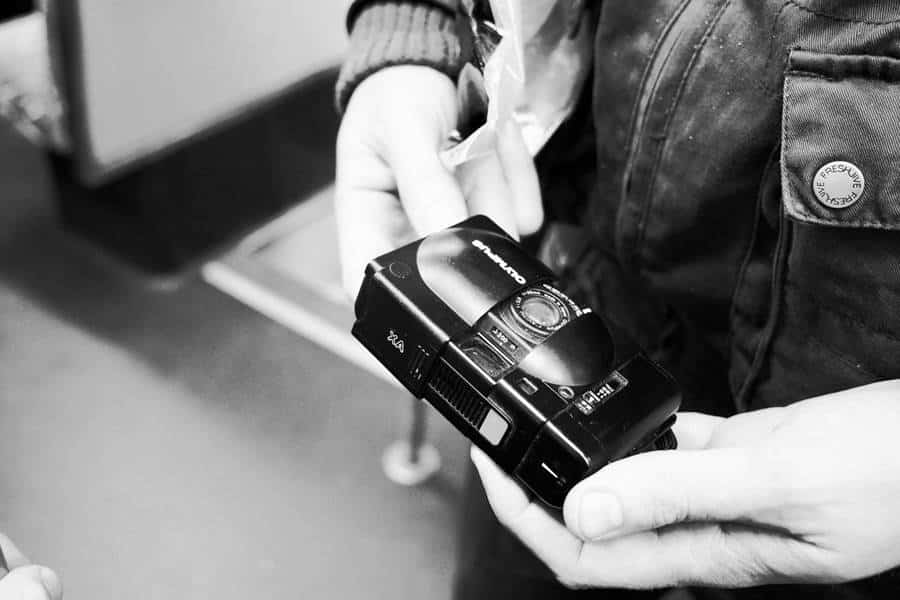To know the high-end brands and top ten Best Wide Angle Lenses of this year, browse this buying guide, here I reviewed the top 10 best-selling wide-angle lenses of the year.
In the world of photography, showing a vast imagination allows the capture of the best moments. But it is also necessary to be equipped with professional lenses whose performance can meet expectations.
If you want flawless results, it is essential to use an excellent quality lens that matches the sensor size of your DSLR. However, the choice of this accessory also depends on the distance from the object you want to photograph. If it is a landscape photo, the device to prioritize is the wide-angle one.
According to the lens quality, features, and best pricing “Canon EF 24mm f/1.4 L II USM” is my first choice and winner of the best wide-angle lenses of the year. There is also “Nikkor Z 24-70mm f/2.8 S,” which gives excellent picture quality and stands in the second position (first in Nikon Brand). But before reviewing wide-angle lenses, let’s see what you need to take care of when buying the best wide-angle lens.
Things to Consider Before Buying A Wide Angle Lens
However, before you start hunting for the best product, I recommend that you first distinguish how to buy a better-value wide-angle lens. Indeed, far from being a simple accessory, this will be an opportunity to invest sustainably.

1. The Quality and Reputation of the Lens
It is always better to prioritize quality, as this can significantly influence the photo’s definition, sharpness, and contrast. And contrary to what one might think, this aspect is intrinsically linked to the brand of the material. As you will have understood, blindly pouncing on the cheapest item you will come across in comparison is a rookie mistake. And firstly, it could be that the model is not compatible with your camera, and secondly, you also run the risk of dishonoring your profession through poor quality renderings.
The difference between a worst and a best wide-angle lens centers on the focal length, which must be less than 24 mm for a full-frame camera and, and less than 18 mm for an APS-C type camera. Such a lens will allow you better to develop your perspectives, ideal for landscape photos.
I, therefore, recommend that you always bet on companies that have already proven themselves in the field and remain attentive to user feedback.
2. Full Frame or APS-C?
This dilemma often arises in determining which is the best wide-angle lens on the market. Indeed, to get the maximum benefit from your purchase, you should not neglect the compatibility of the camera and the lens in question. Yes, if you make the wrong choice, you won’t even place the equipment on your hardware. In other words, models designed for APS-C cannot accommodate a full-frame sensor. And if, by chance, the two elements manage to fit together, the rendering will not be as satisfactory.
For example, if you take a 16-35 mm lens designed for a full-frame while you have an APS-C, as a result, the equivalent of a 24-52 mm will not allow you to get the “wide-angle” effect during photography.
So, before looking for where to buy a new wide-angle lens, I advise you to define the type of camera you have in your possession. If I offered it to you, you would be able to distinguish this aspect in the material instructions.
3. The Maximum Aperture of the Diaphragm
So that you can have an item that can meet your requirements and make a perfect match with your area of intervention, I also advise you to consider this criterion before any purchase.
It is often referred to on the lens and is preceded by the indication “f /”; the smaller the number, the larger the aperture. However, it will not be as necessary to have equipment with a large aperture if your goal is to primarily landscape. Indeed, if this is the case, you will have to work with a figure between f/11 and f/14.
On the other hand, for reports or wedding photos in an enclosed space, this criterion should be considered to know how to choose the best wide-angle lenses. Indeed, a large opening will allow you to benefit from the speed of the faster shutter and blurry renderings in the background. Thus, this aspect should be compared according to your practices.
However, always remember that it will be significantly more beneficial for you to have one model that opens at f/2.8 rather than one at f/4. Moreover, the cost of these two items will be different in the price comparison.
4. Fixed Focal Length or Wide Angle Zoom?
Some photographers do not appreciate constant movement during their shots, others favor movement towards their target to find the ideal point of view. Here, it’s all about preference. A fixed focal length has the advantage of being light and is reputed to offer nice blurs. However, you will have to move to a better frame. On another way, the zoom holds the versatility card and won’t force you to walk, which is perfect for creating quick compositions.
The Top 10 Best Wide Angle Lenses of the Year (Rating & Reviews)
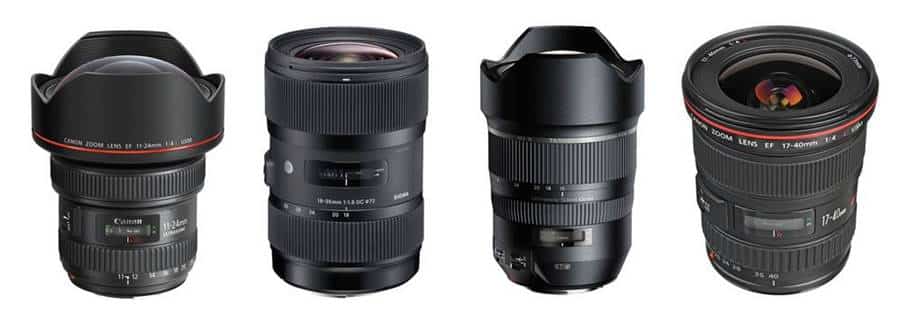
1. Canon EF 24mm f/1.4 L II USM
When trying out different disciplines of photography, it is essential to know how to choose the best lens to best experience this inclination. Without having a unique design that catches the eye, this model has most of the features for this type of accessory.
With a 24mm size shot in wide-angle mode, the photographs provide a greater immersion in the captured image.
Thanks to an aspherical lens and the latest-generation USM motor, the user has a fixed focal length while being as close as possible to the target to be aimed. The large aperture of this instrument also helps reduce the depth of field captured, even at a minimal distance.
As for the mechanism, it provides very rapid autofocus with less sound production. For those who prefer to perform their calibration, manual focus is also accessible. In short, with the help of this model, obtaining sharp images without chronic aberrations is no longer impossible.
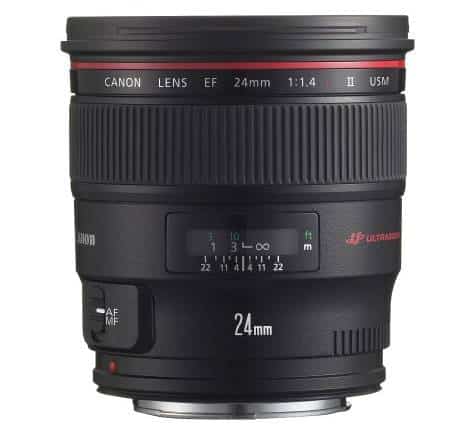
Get It on Amazon for $1549 Today
Pros:
- Accessories: You have a circular polarizing filter and protection, a compatible lens hood, and an extension tube by unpacking the box.
- USM Motor: This essential element is beneficial for optimal shooting for fast aperture and exact focusing.
- The Performance: In an area with little light or at night, the aspherical lens combined with the Super UD treatment delivers sharp shots, depending on your settings.
Cons:
- The Weight: It is a shame that this lens weighs 650 grams with the equipment.
2. Nikon Nikkor Z 24-70mm f/2.8 S Wide Angle Lens
For lovers of versatile photography accessories, the performance of this model makes it very practical, whatever the event to be immortalized. Starting with excellent efficiency regardless of the intensity of the light, this lens is intended for hybrid cameras.
Thanks to a large f/2.8 aperture and a circular diaphragm with nine blades, this lens plays with distance, lighting, and type of capture. Using autofocus and manual focus, the Z mount paired with an optical design with 17 lenses in 15 groupings provides immersive depth to your shots.
To speed up the settings, an AF lock and an OLED screen simplify the photographer’s life. In FX-format, it incorporates an angle of view between 84° to 34° x 20°, and in DX, the figures are from 61° to 22° x 50°. Best of all, its hermetic character makes it a trusted ally in any place and any location.
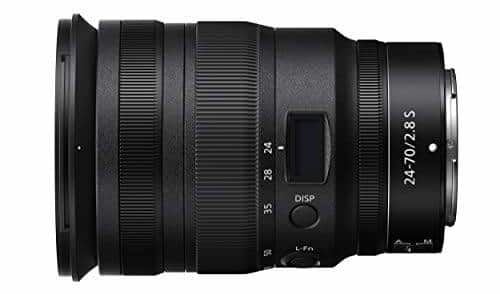
Get It on Amazon for $1997 Today
Pros:
- Convenient: Without wasting time checking the default settings, a monitor displays much information about the current settings of the lens.
- ARNEO Coating: This type of coating process, combined with the nanocrystal, permanently eliminates the parasites produced by an incidence of light.
- Programmable: It is easy to set any function to FN with the 21 options available with an unassigned command.
Cons:
- Compatibility: Only for Hybrid Cameras. For a camera with other models, this lens will not be compatible/suitable.
3. Empire 3 in 1 Smartphone Wide Angle Lens
Before getting started with the camera and thinking about where to buy the best wide-angle lens, why not give it a try with your smartphone? Indeed, this lens is intended for the latest cell phones for even more successful images.
It is equipped with the Fisheye lens; this small lens widens the field of view to near 180°. The advantage lies in the result of the shot, which allows the subject to be captured and its environment without performing various inclinations.
This lens consists of a 145° wide-angle sensor, a macro model with 15 zooms, and another transparent fisheye.
Whatever the brand of your phone and the system, between Android and iOS, these lens will be compatible. By hanging it on your back or front device, the magic of visual art is revealed with the three lenses.
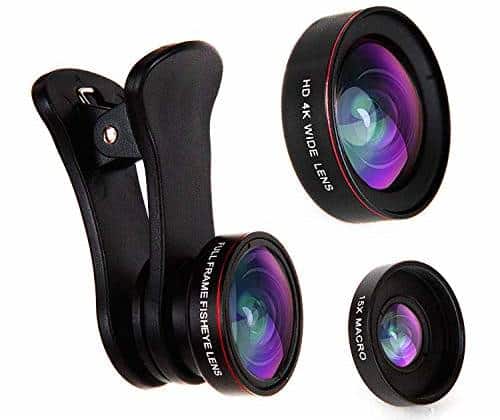
Get It on Amazon for $19.95 Today
Pros:
- The Price: This smartphone accessory offers a cheap cost accessible to the masses to start digital art.
- Universal Model: Without distinguishing between reference or origin, this device is compatible with any phone equipped with a camera.
- Simple: To not complicate the configuration of this product on the laptop, it has a clamp that allows it to be held on the walls of the smartphone.
Cons:
- The Number of Sensors: If acquiring a magnifying zoom lens was part of your intention, this lens does not work.
4. MEIKE 8mm f/3.5 Ultra Wide Angle Lens with Manual Focus
For owners of Nikon cameras equipped with a CMOS sensor, this wide-angle lens promises to come in handy anytime. With a stable 8mm focal length offering excellent effect, it can focus in the space of only 10 cm between the lens and the subject.
Regarding the aperture, it widens over a large field characterized by the symbol f/3.5-f/22. For information on the multiple inclinations, this lens provides a diagonal angle of 200°, horizontal of 160°, and vertical of 104°.
By combining low-light performance and enhanced sharpness, this wide-angle lens has a compact design for less strenuous transport.
The lens structure comprises eight groups with 11 discs to bring together the various accessible shots. Besides the lens, the necessary instruments for its use are included.
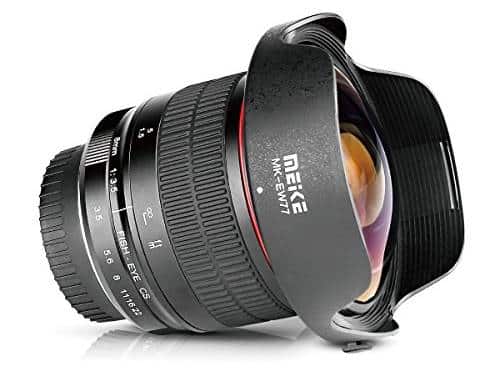
Get It on Amazon for $164.99 Today
Pros:
- Focusing: It is possible to stabilize the sensor in automatic and manual mode, even at 10 cm from its target.
- For CMOS: The DSLR models of the brand are spoiled by this lens which is both versatile and powerful, making it practical if you are looking for a Nikon D3200 wide-angle lens.
- Metal Body: With such a characteristic, the life of this lens is increased without exaggerating efforts during its maintenance.
Cons:
- Weight: Its steel design will have only one drawback: too much weight when mounted on a DSLR.
5. Panasonic Lumix G II, 20MM, F/1.7 (Fixed Focal Length)
If one has an essential requirement for a wide-angle lens, this model is a reasonable alternative for capturing excellent images. This lens is available in a flattened form to minimize the bulk for those not fans of giant sensors.
It weighs only 87 grams, with a length of 2.56 cm and a thickness of 6.3 cm. Its photographic performance incorporates a fixed focal length of 20 mm with a wide F/1.7 aperture.
Without being fooled by its appearance, this lens provides excellent light whether the capturing photos is day or night. Image distortions and aberrations are reduced thanks to 2 aspherical lenses and a design of 7 elements divided into five groups.
Without making any distinction between brands, this model can be installed on micro 4/3 mounts. The minimum focus range with this sensor is 20 cm.
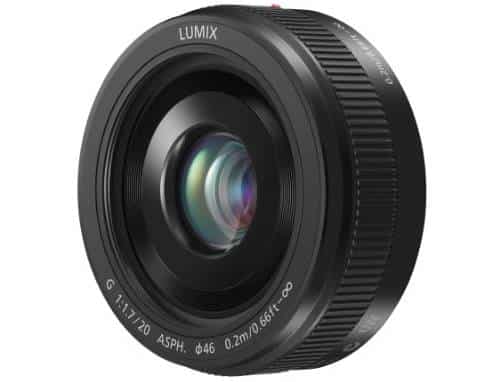
Get It on Amazon for $267.99 Today
Pros:
- Compactness: Knowing what this wide-angle lens can do, its small size and slim design make it even more convenient.
- The Finish: To ensure the longevity of the lens, the manufacturer opts for a metal case, and the result is more than successful.
- Versatility: While it is compatible with several devices with specific frame sizes, it is also effective during both day and night.
Cons:
- Focus: If you are used to professional-type cameras, this model is not responsive to focal stabilization.
6. Sony FE f/2.8 GM
Performing specific effects on photos involves mastering techniques, but also the quality of the equipment. For wide-angle shots, this product has almost everything you need.
On an F/2.8 ground, this lens allows a stable view over a wide variety of dimensions. It is possible to the Sony XA dual lens, which erases distortions and maintains resolution. The 16mm to 35mm focal length offers considerable support to capture what is in the background.
This lens would be an asset to achieve bokeh. The aperture has 11 adjustable slats for a satisfactory blur rendering in the background.
Whether you are a professional or a beginner, the application will not be a problem, as the fast autofocus allows efficient adjustment in no time. In addition, an AR coating has been put in place to limit disturbing light shots.
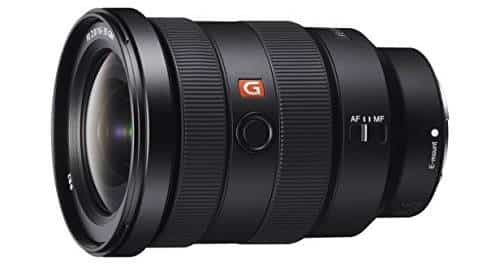
Get It on Amazon for $1988 Today
Pros:
- Artistic: Playing on the background blur is a specialty of this model, as it can enhance the aspect of the horizon without spoiling the environment.
- Compact: This lens does not present too much space for the user, hence its excellent maneuverability, even in difficult positions.
- Efficient: Due to the complexity of the components and their reaction, it is possible to achieve beautiful images quickly.
Cons:
- The Rendering: Unfortunately, the vignetting seems marked on the broader opening, spoiling the expected result.
7. Universal 3 in 1 Smartphone Lens
Even with a smartphone, it is possible to perfect your photos by simply adding equipment. It is mainly the case with this affordable 3 in 1 portable lens. It sets in as quickly as it withdraws. Thanks to a clip-on fixing system, it is placed directly on the opening of your phone’s camera to perform the effects.
You will find three interchangeable parts in the set: a macro, a micro, and a fisheye; the latter allows specific characteristics to be highlighted based on its convex lenses. You will thus obtain a distorted view on 235°, with a unique perspective.
The other two can be used to extend or provide precision when taking. This kind of lens is compatible with most devices on the market, but in any case, it is compulsory to check before purchasing.
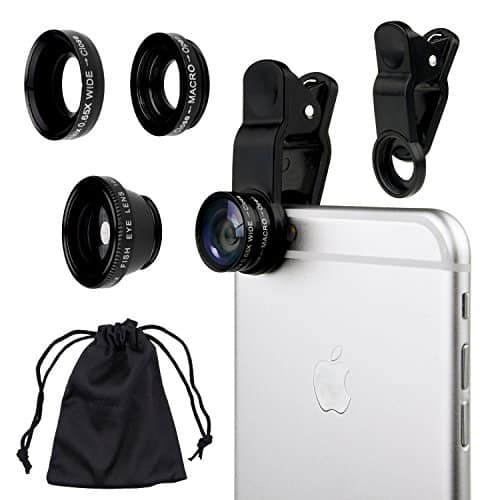
Get It on Amazon for $12.49 Today
Pros:
- Nomad: Anywhere and anytime, this accessory can be operated without power. Plus, it doesn’t take up much space in a bag.
- Fixing: You will be able to take pictures in just a few manipulations. The clamp fits, in fact, most models of smartphones.
- Kit: No longer limit yourself to a single lens, this bundle has 3 for a wider variety of effects. Explore all the possibilities of your device.
Cons:
- Compatibility: On some devices, the equipment does not attach properly. Remember to check this detail before buying.
8. Pentax FA 35mm F/2 Versatile Wide Angle Lens
Which wide-angle lens to choose? For those who are in the K series, this model has advantages that might interest professionals. In particular, it is suitable for the wide grip at 35 mm with a high-quality rendering.
Whether for a snapshot, a landscape, or other application, this lens has excellent versatility in addition to its ease of use. For an adequate grip, the lens is accompanied by a mechanical SR stabilization. It will allow you to adjust imperfections in the field quickly.
Equipped with an improved aspherical lens, this model can keep good sharpness even at a certain distance. The SP treatment applied will guarantee its longevity because it has optimal protection against water and dust. Weighing 193 grams, this material offers good ergonomics with proven compactness for travel.
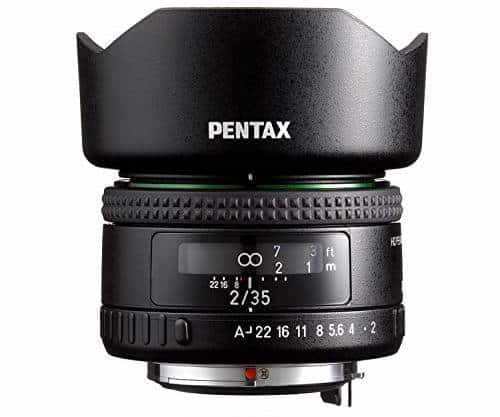
Get It on Amazon for $346.95 Today
Pros:
- Hybrid Lens: Able to obtain a stable image over different distance levels, these components are essential for illustrating in detail.
- Portable: Having a compact shape, fragility is minimized, and the tool can be moved with peace of mind.
- Good Value for Money: If we refer to its weight and its gripping qualities, it is clear that this device is offered at an attractive price.
Cons:
- Limited Compatibility: Although it shows good results, it is not suitable for some camera models by its digital system.
9. Sigma 16 mm F/1.4 DC DN Contemporary
Before looking for the best brand of wide-angle lenses, it’s best to focus on your actual needs. If it is compatible with your device, this model has quite specific characteristics. With an aperture of f/1.4, it is capable of delivering sharp images.
The general controlled behavior gives it an easy grip for beginners as well as for pros. There is also an unquestionable comfort in handling the exact focusing ring. What distinguishes this item would be its resistance: it is marked by solid construction. This structure gives it optimal protection against bad weather and challenging conditions.
Image correction is not limited to the lens alone; the exterior assembly and edges reduce vignetting and distortion. The same is also true for the quality of the lenses.
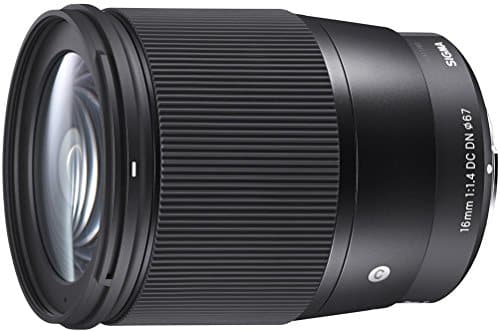
Get It on Amazon for $379.99 Today
Pros:
- Resistant: The manufacturers have given themselves the means on this model; we notice this by its reinforced design. It can be helpful even when severely tested in bad weather.
- Precise Controls: Manual adjustment on the lens allows easy use of different perspectives.
- Sharpness: In its specific field, f/1.4, it delivers a good performance, especially image quality.
Cons:
- In addition to being quite bulky, it seems useless at the wide opening.
10. Panasonic Leica Wide Angle Zoom Lens
Buying a good lens doesn’t have to be looking for the most efficient and expensive one because sometimes you should try versatile models like this. With a focal range of 8 to 18 mm, this lens can achieve an f/2.8 shot.
What specifies it of others, in particular, lies in its proven maneuverability. It also has good visibility, especially for wide-angle shots. Its optimal build quality gives it ease of use and long-term strength. Those who are effect lovers will not be disappointed with the performance of this item.
According to professional advice, other factors that could affect the final rendering of the image should be monitored. Precisely, this material is provided with weak vignetting and control of the distortions. Nonetheless, it lacks homogeneity of the sharpness to some extent.
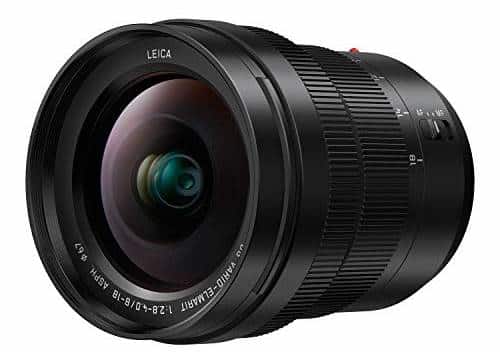
Get It on Amazon for $997.99 Today
Pros:
- Efficient: This is the right accessory for shooting in extreme conditions where precision is not much needed. Even in the absence of focus, it comes out with optimal renderings.
- Lightweight: With a weight of approximately 300 grams, the user will not be in any way encumbered when traveling.
- Fluid: The passage from 8 to 18 mm is carried out straightforwardly. It will be possible to work the field at any time and take quick shots.
Cons:
- Image: Although this equipment shows excellent performance, homogeneity defects were seen in the pictures.
Frequently Asked Questions

Q1: What is a wide-angle lens?
There are different kinds of lenses that can be used to obtain tables of varying resolution. To take a landscape photo, the wide-angle one is most appropriate. Thanks to its short focal length, the lens has an extensive viewing angle called a wide-angle lens, which can be adjustable or fixed. With the first type, it is easy to perform zooms to enlarge the images you want to capture.
However, with the other genre, it is only possible to take panorama photos. It then allows the visualization of everything you have in front of you. Still, it is not recommended to take portraits if this is the kind of lens you are using, as it will distort the edges and not show the face’s sharpness.
You may also like to read: Canon EF 24mm f/1.4L II USM – The Best Wide Angle Lens
Q2: Why a wide-angle lens?
If you have creativity, this type of lens is the best for you. Indeed, it gives a very extensive framing and opens up space in a photo. So you have a large surface to make a very successful image composition. However, you must be careful with its use because parasites could stain without your being aware of it by encompassing the entire scene.
The system of this lens also offers a certain depth that allows the background of a subject to be captured in crispness. Plus, its compact and lightweight characters reduce motion blur when shooting, even if you’re working in a low-light place. It is available in a lot of models which are all professional.
You may also like to read: Advantages of Wide Angle Lens: Why is the Wide Angle Lens So Popular in Photography?
Q3: How to recognize a wide-angle lens?
If you are still new to the world of photography, it is expected that you do not know how to identify this kind of lens at first glance. When making your purchase, you must check each character of the product in question one by one.
First of all, the focal length must be short: if it is below 28 to 24 millimeters, it means that it is a wide-angle lens. When this point is above this margin, a telephoto lens does not allow the field of vision to be widened. And this other genre usually has a focal length of 50 millimeters and more.
You may also like to read: What is the Best Canon Wide Angle Lens of 2020?
Q4: When to use a wide-angle lens?
This lens allows you to vary the scenes taken since it will enable the zooming of various magnitudes. On the one hand, the best opportunity to use it is when you want to photograph a landscape with a panoramic view mode.
But it’s just as easy to take portraits with a high-quality, deep background included. On the other hand, if you are looking for a circular view of the surroundings you want to capture, you can use a short focal length fisheye lens that will distort the horizon line for a very modern rendering.
